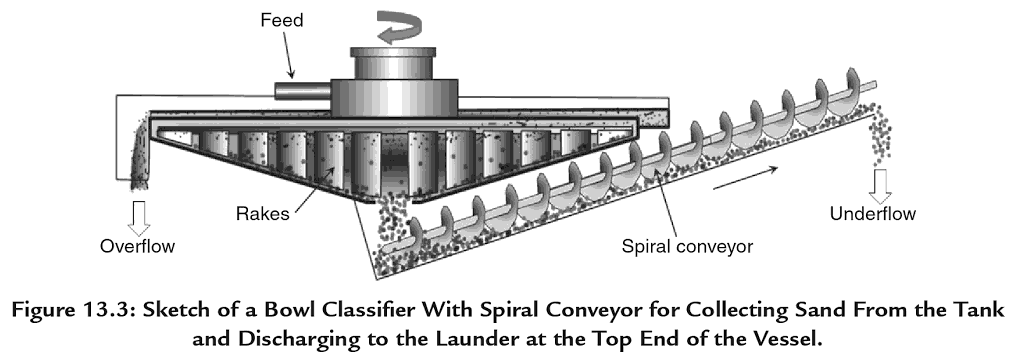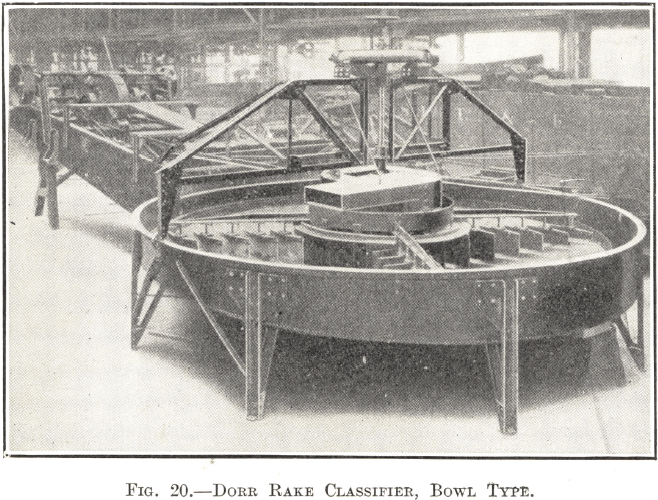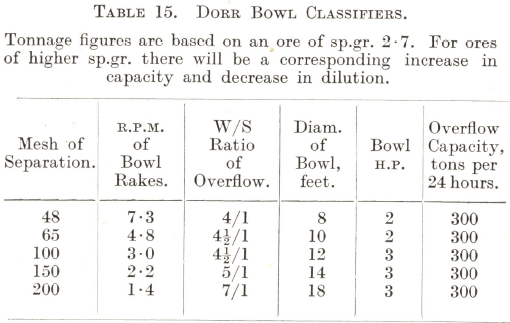The bowl classifier incorporates a two-stage baffled-return separating action, and it consists of a straight classifier with the usual reciprocating rakes, upon which is superimposed at the lower end a shallow circular bowl with a revolving rake mechanism. The general construction of the Dorr Bowl Classifier is shown in Fig. 20.
The feed enters at the centre of the bowl, and, falling on to a baffle-plate placed at the level of the surface of the pulp, is directed radially outwards. In passing from the centre to the periphery the coarser particles settle and only the fines overflow into the annular launder provided for the purpose. The oversize, as it settles, is ploughed to the centre by the revolving rakes and discharged through a rectangular opening into the second stage or reciprocating rake compartment, where it is dragged up along the sloping bottom of the tank exactly as in a straight classifier.
The movement of the rakes in the restricted space beneath the bowl is regulated to give enough agitation to throw the finer solids into suspension. The diluting water is added in the reciprocating rake compartment ; it flows back towards the bowl and then up through the opening in the bottom. This back flow is of sufficient velocity and quantity to carry the solids thrown into suspension by the rakes back into the bowl for re-classification. A final cleaning of the oversize is affected by the rakes as they turn over the sand in dragging it up the slope and by a water spray which washes it at its point of emergence from the pulp.
The main adjustment for regulating the mesh of separation is the W/S ratio in the bowl, since this determines the density of the pulp and therefore the settling rate of the solids, just as it does in a straight classifier, but the surface area available for settlement in the bowl can be made much greater than that available for the same purpose in the tank of a straight classifier designed to do the same work ; consequently a denser pulp will be necessary in the former machine to give the same mesh of separation as in the latter. It is because a bowl classifier can be made to give an efficient separation in a thick pulp that it is so useful when a product of 100 mesh or finer is required. Its place in fine-grinding flotation plants for this purpose is well established. On account of its efficiency it is also coming into use in installations which require a separation at 65 or even 48 mesh. For a coarse product a much smaller bowl is employed ; the area available for the settlement of the sand is actually smaller than that available in the tank of a straight classifier designed for the same work, and the pulp has to be thinner in consequence although it is still thick enough for flotation purposes. It is the greater efficiency of the two-stage method of separation in a bowl classifier as compared with one of the straight type, and not considerations of pulp density, that makes it preferable in many cases for coarse separations.
Table 15 gives particulars of the standard sizes of Dorr Bowl Classifiers. They can be provided with the Model D or the Model F raking mechanism in the Simplex, Duplex, or Quadruplex form according to the raking capacity required, the slope of the tanks being 2 in. per foot for all sizes of bowls. The “ Bowl h.p.” figures in the table represent sizes of motors ; the actual power consumed will be about two-thirds of the amount given. It is usual to fit the bowl motor with a variable speed device in order that the raking capacity in the bowl can be accommodated to the quantity of oversize to be handled.
